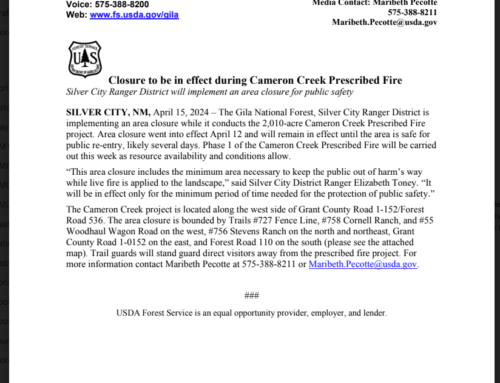Here’s a look at today’s headlines:
A new fire was detected on the Wilderness District in the Gila National Forest on Sunday. The Turkey Fire is lightning-caused, estimated at 107 acres and located in the Gila Wilderness approximately eight miles southwest of the Gila Cliff Dwellings National Monument. It is also situated within the pre-determined management area for the McKenna Fire. Wilderness Ranger District officials have decided to manage this incident to remove hazardous fuels, reduce the severity of future wildfires and minimize exposure to firefighters. The McKenna Fire, which started by lightning on May 6th, is estimated at 10,000 acres. Fire activity on the Turkey and McKenna fires is reported as creeping and smoldering.
The North Fire on the Magdalena Ranger District is now 12,495 acres and 20% contained. Acreage will increase daily as ignition operations continue. The North Fire is being managed for multiple resource benefits.
US Senator Martin Heinrich highlighted Project ECHO, the Extension for Community Healthcare Outcomes, a program started by the University of New Mexico that has become a national model for providing remote communities with access to high quality health care resources. Project ECHO uses technology-enabled collaborative learning to support community providers and dramatically increases access to specialty treatment in remote and underserved areas.
US Senators Tom Udall and David Vitter of Louisiana announced Senate passage by voice vote of the final agreement on their landmark bipartisan legislation to reform the Toxic Substances Control Act of 1976. The final legislation, titled the Frank R. Lautenberg Chemical Safety for the 21st Century Act, will overhaul the current broken law, which has allowed tens of thousands of chemicals – including hundreds that Americans come into contact with in daily life – to go on the market without any evaluation for safety. With Senate passage, the agreement is now headed to the president’s desk, and the president is expected to sign it soon.
The New Mexico Deparment of Health announced that drug overdose deaths in the state decreased by 9 percent last year. Preliminary mortality data from 2016 shows that the number of drug overdose deaths among New Mexicans dropped from 540 in 2014 to 492 in 2015. Drug overdose death is the leading cause of injury death in New Mexico and nationally, exceeding deaths from motor vehicle traffic crashes and falls.
Read our earlier post for the unofficial election results affecting Grant, Luna and Hidalgo Counties according to the Secretary of State. The Grant County votes are not considered final and official until canvassed by the Grant County Commission, which will occur on June 14th at 9 am.



